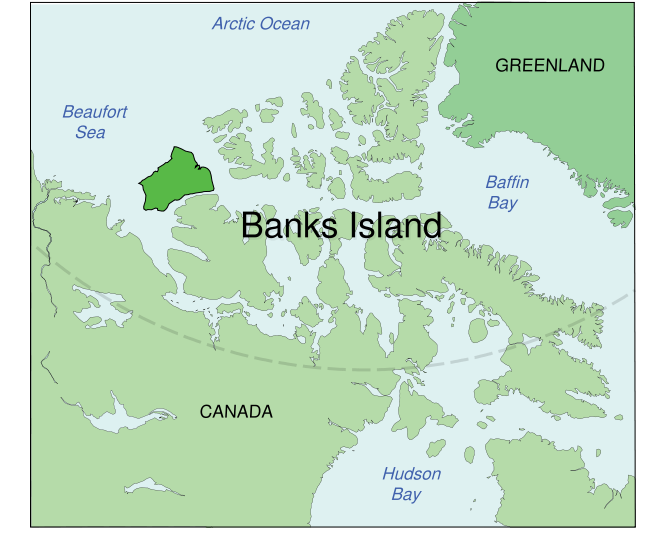Banks Island
The Bank Island (english Banks Iceland ) is the fifth largest island in Canada, one of the 25 largest islands in the world and the westernmost island in the Canadian Arctic Archipelago -.
It was named in honor of the famous English naturalist Sir Joseph Banks and is one of the Northwest Territories. She was discovered by Frederick William Beechey, who served as a lieutenant under the British polar explorer Sir William Edward Parry in whose expedition 1819/20.
Geography
The narrow Prince of Wales Strait separates the island on the east bank of the Victoria Island. The McClure Strait in the north separates it from the Prince Patrick Island and Melville Island, the Amundsen Gulf in the south from the Canadian mainland. In the west, the island is adjacent to the Beaufort Sea. It is located at about 71 ° to 75 ° north latitude and 115 ° to 126 ° west longitude, is 70,028 km ² in size (roughly the size of Bavaria ), 400 km long and 180-290 km wide. The island was inhabited by the Inuit. Today it is apart from the staff of the air force base Sachs Harbour on the southwest coast, largely uninhabited ( 2006: 122 inhabitants) and is only occasionally visited by trappers.
The landscape consists mostly of lowlands, just to the east there are the Durham Heights to 730 m high hill country, in the surrounding vegetation is tundra.
Fauna
The fauna consists of large herds of musk oxen. The Thompson River Valley is the world's most important habitat for these animals. In addition, Arctic foxes, ptarmigan, ravens and some herds of endangered Peary caribou living on the island. 1961 two protected areas for migratory birds ( Migratory Bird Sanctuary Iceland Banks I and II ) were established, which are recognized by BirdLife International as an Important Bird Areas NT017 and NT043. One of the largest breeding colonies of the Lesser Snow Goose is located at the mouth of the Egg River in the Big River in the southwest of the island bench with 479 500 birds in 1995. A total of 43 different bird species live temporarily on the island. Today, the Aulavik National Park protects 12,274 km ² arctic lowlands to the north of the island, including the valley of the Thomsen River, which is one of the northernmost navigable rivers in North America.
Trivia
In the search for survivors of the Franklin expedition led the British navigator Robert McClure in 1850 to the bank island. Upon passing the Prince of Wales Strait his ship HMS Investigator was trapped by the ice, and the crew wintered there of necessity. At the retreat of the ice the following spring McClure discovered the island and called it on his card in apparent unawareness as Baring Iceland. He began to circle the island, but was in September 1851 in the Mercy Bay, a bay in the north of the island, again stopped by pack ice. Almost 3 years awaited the team out there, then the castaways went with slide for Melville Island, where they were rescued by the HMS Resolute. They left the ship itself, which sank in 2010 and later rediscovered by Canadian archaeologists using sonar equipment in about eight meters deep.
On Bench Island, the first grizzly - polar bear hybrids was killed ( by an amateur hunters ), which could be clearly identified through DNA testing as such.










